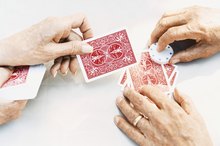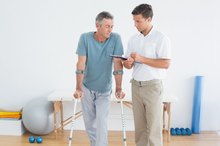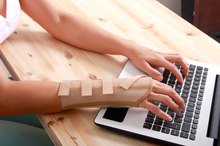What does fact checked mean?
At Healthfully, we strive to deliver objective content that is accurate and up-to-date. Our team periodically reviews articles in order to ensure content quality. The sources cited below consist of evidence from peer-reviewed journals, prominent medical organizations, academic associations, and government data.
The information contained on this site is for informational purposes only, and should not be used as a substitute for the advice of a professional health care provider. Please check with the appropriate physician regarding health questions and concerns. Although we strive to deliver accurate and up-to-date information, no guarantee to that effect is made.
Sensory Activities for Occupational Therapy
Decreased sensation can result from a stroke, brain injury or nerve damage. Hypersensitivity to touch can also result from nerve damage, along with burns, phantom limb syndrome that occurs after limb amputation and developmental disorders. A variety of strategies may be used by your occupational therapist to facilitate normalized sensation and increased functional use of your hand or leg.
If you are experiencing serious medical symptoms, seek emergency treatment immediately.
Phantom Limb Syndrom
After having an arm or leg amputated, your body may not be able to process the change the nerves may become hypersensitive, making you feel as though your limb is still in place, but it has been severely hurt. This can result from nerve endings surgically wrapped around the end of the stump, which is commonly done in amputation surgery. By providing stimulation to your stump end, you can agitate the nerve endings repeatedly and this will help to reduce your hypersensitivity. Your therapist may use gentle touch, towel rubbing, pencil eraser taps or friction massage to sequentially increase your tolerance of touch, pressure and tactile stimulation.
- After having an arm or leg amputated, your body may not be able to process the change the nerves may become hypersensitive, making you feel as though your limb is still in place, but it has been severely hurt.
- By providing stimulation to your stump end, you can agitate the nerve endings repeatedly and this will help to reduce your hypersensitivity.
Hypersensitivity Disorders
Occupational Therapy Activity Ideas for CVA
Learn More
Many children with developmental delays or people with brain injuries may also suffer from hypersensitivity. Often described as sharp, shooting, "pins-and-needles" the pain associated with touch can be debilitating and limit all use of your limb 1. By stroking your hypersensitive area, or providing other tactile stimulation you can reduce your nerve's reaction to touch and decrease your pain. Once your sensation has normalized, you can start to train or retrain your body to use the affected limb.
- Many children with developmental delays or people with brain injuries may also suffer from hypersensitivity.
- By stroking your hypersensitive area, or providing other tactile stimulation you can reduce your nerve's reaction to touch and decrease your pain.
Desensitization
Poor or absent sensation can be dangerous because you can injure your arm or leg without being aware of it. Furthermore, the numb feeling in your limb will hinder your functional use of the limb. By providing vibration and stimulation to the affected limb, your therapist can stimulate the nerves and attempt to rejuvenate any affected areas of the brain that are contributing to the decreased sensation. Your therapist will cue you to observe your affected limb visually to reconnect the neural pathways between your brain and your limb to improve your sensation.
- Poor or absent sensation can be dangerous because you can injure your arm or leg without being aware of it.
- By providing vibration and stimulation to the affected limb, your therapist can stimulate the nerves and attempt to rejuvenate any affected areas of the brain that are contributing to the decreased sensation.
Occupational Tasks
Occupational Therapy Exercises for Lifting Arms
Learn More
Once your sensation has begun to normalize, your therapist will begin to introduce functional sensation activities, which are similar for desensitization and hyper-sensitization. Items such as a penny, a paper clip and a clothespin will be dropped into a bucket of pudding or rice and your therapist will ask you to retrieve these items. This type of activity forces you to use your sensation to differentiate between different surfaces and tactile cues and fine tunes your sensation.
Related Articles
References
- The War Amps: Phantom Limb Pain
- National Institute of Neurological Disorders and Stroke: Post-Stroke Rehabilitation Fact Sheet
- Braddom RL. Physical Medicine and Rehabilitation. New York, NY: Elsevier Health Sciences; 2010.
- Potok B. Everything you need to know about desensitization exercises. Amputee Store. August 5, 2018.
Writer Bio
Melissa Sabo is an occupational therapist who started writing professional guidebooks for all Flagship Rehabilitation employees in 2009. Specializing in applied therapy and exercise for non-medical readers, she also coauthored a manual on wheelchair positioning. She graduated from the University of Pittsburgh with a Bachelor of Science in occupational therapy.









